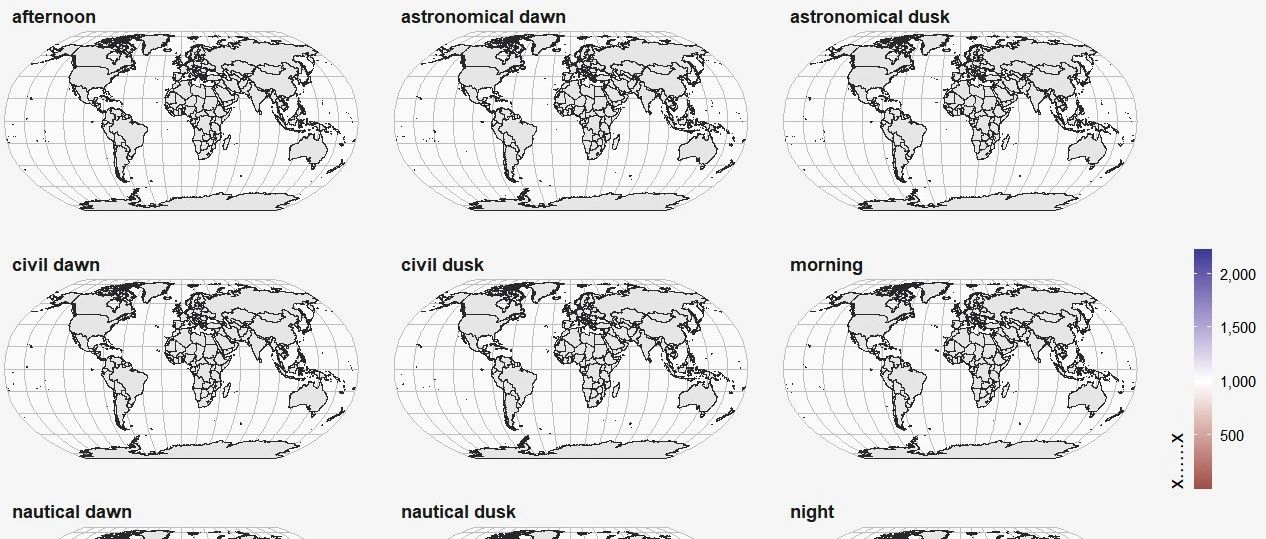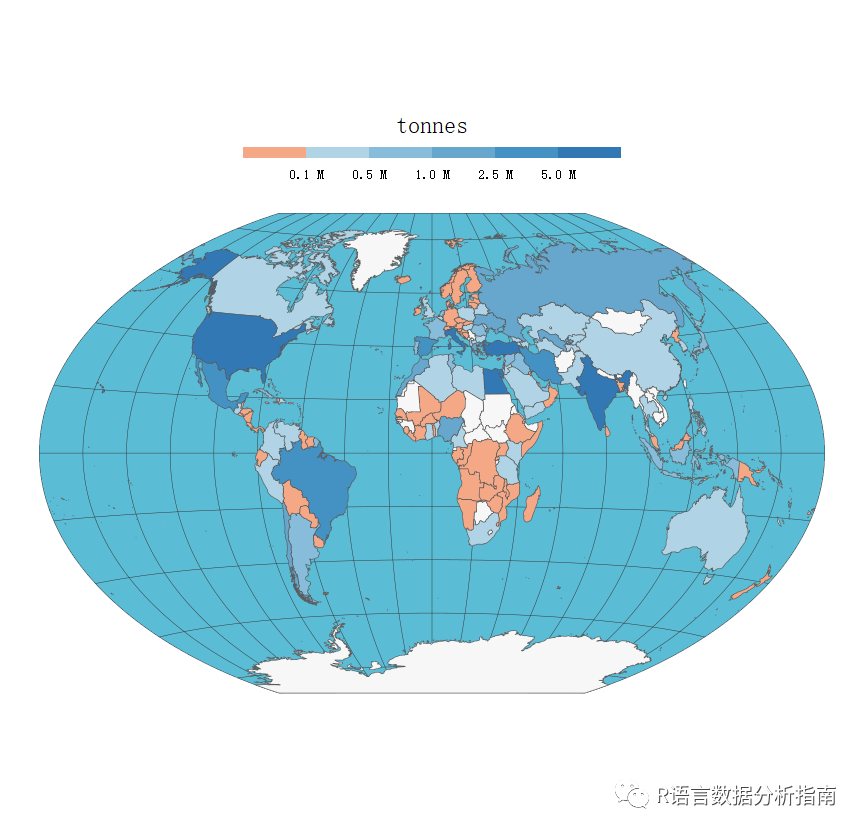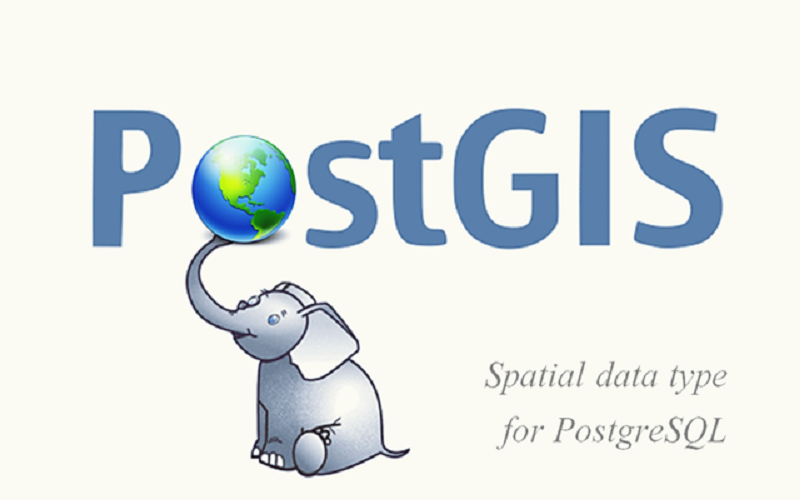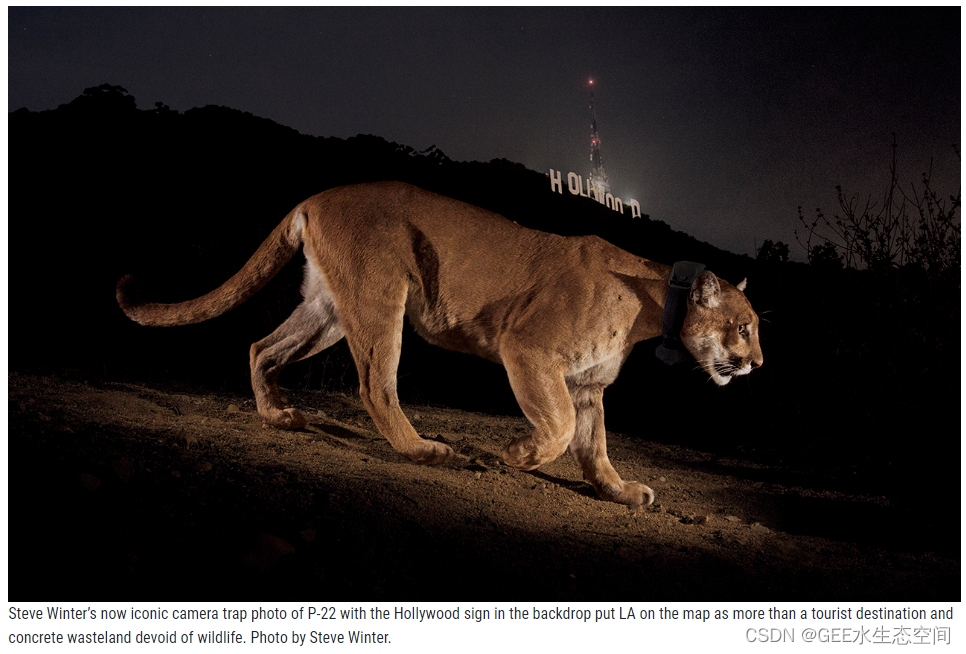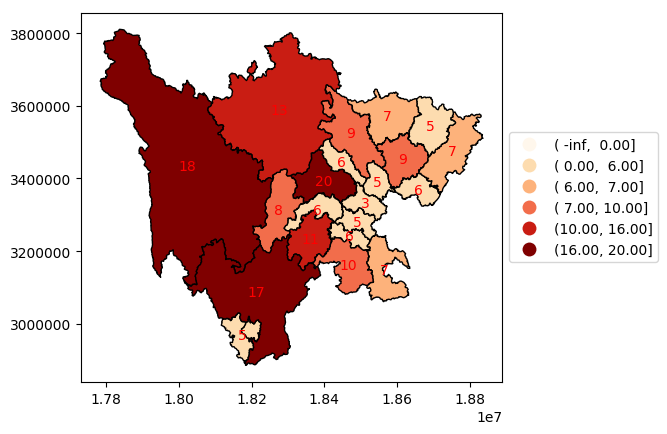空间数据处理(一)
空间数据处理(一)

Spatial 数据简介
Vector data
空间数据的主要形式,类型是点、线和多边形。
点:数据结构为坐标对和附带的值,比如一个地点的温度和它附带的信息比如站点
线:线指的是一系列线段组成的结构,比如河流
多边形:为封闭的折线,起始坐标和终点坐标一致
Raster data
栅格数据通常用于表示空间连续现象,如海拔。栅格将世界划分为大小相同的矩形网格,在遥感数据中称为像素,所有这些网格都有一个或多个值(或缺失值)的变量。栅格单元值通常应该代表它所覆盖区域的平均(或大多数)值或者是中心点的值
与矢量数据相比,栅格数据并不显示存储坐标。通过划分范围来确定,从行数和列数来确定每个单元格的分辨率。
空间数据的简单例子
这里的例子是10个气象站的位置和它们每年的降水量
# 导入和下载需要的包
options("repos" = c(CRAN="https://mirrors.tuna.tsinghua.edu.cn/CRAN/"))
# install.packages("rgdal",dependencies = T)
# install.packages("sp")
# install.packages("raster")
library(raster)
library(sp)
# 气象站名字模拟,A-J
name <- LETTERS[1:10]
# 经纬度模拟
longitude <- c(-116.7, -120.4, -116.7, -113.5, -115.5,
-120.8, -119.5, -113.7, -113.7, -110.7)
latitude <- c(45.3, 42.6, 38.9, 42.1, 35.7, 38.9,
36.2, 39, 41.6, 36.9)
# 合并经纬度为矩阵
stations <- cbind(longitude, latitude)
# 模拟降水量数据
# runif函数生成随机正态分布数0-1
set.seed(0)
precip <- round((runif(length(latitude))*10)^3)
# 根据降水量设置点的大小
psize <- 1 + precip/500
# 绘制点图
plot(stations, cex=psize, pch=20, col='red', main='Precipitation')
# 气象站点名字添加
text(stations, name, pos=4)
# 添加图例
breaks <- c(100, 250, 500, 1000)
legend.psize <- 1+breaks/500
legend("topright", legend=breaks, pch=20, pt.cex=legend.psize, col='red', bg='gray')

接下来添加线段和几何图形
lon <- c(-116.8, -114.2, -112.9, -111.9, -114.2, -115.4, -117.7)
lat <- c(41.3, 42.9, 42.4, 39.8, 37.6, 38.3, 37.6)
# 此对象为几何图形的经纬度
x <- cbind(lon, lat)
# 绘制气象站坐标
# stations 为包含经纬度的矩阵
plot(stations, main='Precipitation')
# 绘制不规则几何图形ploygon函数,可以不用首位点相同
polygon(x, col='blue', border='light blue')
# 将气象站使用线段链接
lines(stations, lwd=3, col='red')
# 绘制几何图形的点的位置
points(x, cex=2, pch=20)
# 绘制气象站的点
points(stations, cex=psize, pch=20, col='red', main='Precipitation')上述的代码只是简单的实现地图绘制的点、线、几何图形的方式。
Vector 数据
在处理矢量数据的时候,为了方便编写函数,因此定义了很多的类,也就是面向对象,这些类被很多包使用,sp包是处理空间数据的包,虽然sf包也在慢慢完善,但是sp仍然是使用最多的包。
sp包引入了许多类的名称包括:对于矢量数据SpatialPoints,SpatialLines,SpatialPolygons分别代表点、线、几何图形。如果需要包含数据,那么对象为SpatialPointsDataFrame,SpatialLinesDataFrame,SpatialPolygonsDataFrame。接下来从头创建一些空间对象。
SpatialPoints
#建立数据框
longitude <- c(-116.7, -120.4, -116.7, -113.5, -115.5, -120.8, -119.5, -113.7, -113.7, -110.7)
latitude <- c(45.3, 42.6, 38.9, 42.1, 35.7, 38.9, 36.2, 39, 41.6, 36.9)
lonlat <- cbind(longitude, latitude)
创建spatialpoints对象
library(sp)
pts <- SpatialPoints(lonlat)
# 查看类型
class (pts)
## [1] "SpatialPoints"
## attr(,"package")
## [1] "sp"
# 查看具体内容
showDefault(pts)
## An object of class "SpatialPoints"
## Slot "coords":
## longitude latitude
## [1,] -116.7 45.3
## [2,] -120.4 42.6
## [3,] -116.7 38.9
## [4,] -113.5 42.1
## [5,] -115.5 35.7
## [6,] -120.8 38.9
## [7,] -119.5 36.2
## [8,] -113.7 39.0
## [9,] -113.7 41.6
## [10,] -110.7 36.9
##
## Slot "bbox":
## min max
## longitude -120.8 -110.7
## latitude 35.7 45.3
##
## Slot "proj4string":
## CRS arguments: NA
可以看到有一个bbox,这是一个框,显示的是整个数据涵盖的经纬度范围,通过这四个值,经纬度两两匹配,可以确定四个角的经纬度。proj4string是坐标投射的算法,这里没有指定,所以为NA。
指定投射方式为+proj=longlat +datum=WGS84
crdref <- CRS('+proj=longlat +datum=WGS84')
pts <- SpatialPoints(lonlat, proj4string=crdref)
# 使用spatialpoint穿件spatialpointdataframe
precipvalue <- runif(nrow(lonlat), min=0, max=100)
df <- data.frame(ID=1:nrow(lonlat), precip=precipvalue)
# 将降水量数据集与spatialpoints合并
ptsdf <- SpatialPointsDataFrame(pts, data=df)
ptsdf
## class : SpatialPointsDataFrame
## features : 10
## extent : -120.8, -110.7, 35.7, 45.3 (xmin, xmax, ymin, ymax)
## crs : +proj=longlat +datum=WGS84 +no_defs
## variables : 2
## names : ID, precip
## min values : 1, 6.17862704675645
## max values : 10, 99.1906094830483
# 查看内容
showDefault(ptsdf)
## An object of class "SpatialPointsDataFrame"
## Slot "data":
## ID precip
## 1 1 6.178627
## 2 2 20.597457
## 3 3 17.655675
## 4 4 68.702285
## 5 5 38.410372
## 6 6 76.984142
## 7 7 49.769924
## 8 8 71.761851
## 9 9 99.190609
## 10 10 38.003518
##
## Slot "coords.nrs":
## numeric(0)
##
## Slot "coords":
## longitude latitude
## [1,] -116.7 45.3
## [2,] -120.4 42.6
## [3,] -116.7 38.9
## [4,] -113.5 42.1
## [5,] -115.5 35.7
## [6,] -120.8 38.9
## [7,] -119.5 36.2
## [8,] -113.7 39.0
## [9,] -113.7 41.6
## [10,] -110.7 36.9
##
## Slot "bbox":
## min max
## longitude -120.8 -110.7
## latitude 35.7 45.3
##
## Slot "proj4string":
## CRS arguments: +proj=longlat +datum=WGS84 +no_defs
SpatialLines 和 SpatialPolygons
制作线,这里的函数均来自raster
lon <- c(-116.8, -114.2, -112.9, -111.9, -114.2, -115.4, -117.7)
lat <- c(41.3, 42.9, 42.4, 39.8, 37.6, 38.3, 37.6)
lonlat <- cbind(lon, lat)
# 使用splines函数制作线
lns <- spLines(lonlat, crs=crdref)
lns
## class : SpatialLines
## features : 1
## extent : -117.7, -111.9, 37.6, 42.9 (xmin, xmax, ymin, ymax)
## crs : +proj=longlat +datum=WGS84 +no_defs
制作几何图形,几何图形的对象结构较为复杂,不做展开
# 使用函数sppolygons
pols <- spPolygons(lonlat, crs=crdref)
pols
## class : SpatialPolygons
## features : 1
## extent : -117.7, -111.9, 37.6, 42.9 (xmin, xmax, ymin, ymax)
## crs : +proj=longlat +datum=WGS84 +no_defs
绘制线和几何图形
plot(pols, axes=TRUE, las=1)
plot(pols, border='blue', col='yellow', lwd=3, add=TRUE)
points(pts, col='red', pch=20, cex=3)

Raster 数据
栅格数据处理主要使用的是raster包。raster包主要的三个对象,RasterLayer,RasterBrick,RasterStack。
RasterLayer
RasterLayer对象表示单层栅格数据。一个RasterLayer对象存储一些描述它的基本参数。这些参数包括列和行数、空间范围和坐标参考系统。此外,RasterLayer可以存储单元值的文件的信息。
创建RasterLayer
# 创建一个10行10列的栅格数据框架
r <- raster(ncol=10, nrow=10, xmx=-80, xmn=-150, ymn=20, ymx=60)
r
## class : RasterLayer
## dimensions : 10, 10, 100 (nrow, ncol, ncell)
## resolution : 7, 4 (x, y)
## extent : -150, -80, 20, 60 (xmin, xmax, ymin, ymax)
## crs : +proj=longlat +datum=WGS84 +no_defs
# 给栅格数据单元添加值
values(r) <- 1:ncell(r)
r
## class : RasterLayer
## dimensions : 10, 10, 100 (nrow, ncol, ncell)
## resolution : 7, 4 (x, y)
## extent : -150, -80, 20, 60 (xmin, xmax, ymin, ymax)
## crs : +proj=longlat +datum=WGS84 +no_defs
## source : memory
## names : layer
## values : 1, 100 (min, max)
绘制图形
plot(r)
# 添加几何和线段
lon <- c(-116.8, -114.2, -112.9, -111.9, -114.2, -115.4, -117.7)
lat <- c(41.3, 42.9, 42.4, 39.8, 37.6, 38.3, 37.6)
lonlat <- cbind(lon, lat)
# 绘制几何图形
pols <- spPolygons(lonlat, crs='+proj=longlat +datum=WGS84')
# 添加点
points(lonlat, col='red', pch=20, cex=3)
# 绘制几何点
plot(pols, border='blue', lwd=2, add=TRUE)

RasterStack和RasterBrick
在大多数的情况下,使用的是单层的栅格数据分析,但是在一些案例中,需要使用到多层数据,因此引入RasterStack和RasterBrick。RasterStack针对的是单一的多层文件,RasterBrick针对的是多个文件
事实上,Rasterstack是具有相同空间范围和分辨率的RasterLayer对象的集合。
RasterBrick是一个真正的多层对象,处理RasterBrick比处理表示相同数据的Rasterstack更有效.
制作RasterStack
# r是rasterlayer
r2 <- r * r
r3 <- sqrt(r)
# 使用stack函数,建立rasterstack对象
s <- stack(r, r2, r3)
s
## class : RasterStack
## dimensions : 10, 10, 100, 3 (nrow, ncol, ncell, nlayers)
## resolution : 7, 4 (x, y)
## extent : -150, -80, 20, 60 (xmin, xmax, ymin, ymax)
## crs : +proj=longlat +datum=WGS84 +no_defs
## names : layer.1, layer.2, layer.3
## min values : 1, 1, 1
## max values : 100, 10000, 10
# 绘制图像
plot(s)

可以看到对象s有三个层,使用brick可以转换stick对象为brick
b <- brick(s)
b
## class : RasterBrick
## dimensions : 10, 10, 100, 3 (nrow, ncol, ncell, nlayers)
## resolution : 7, 4 (x, y)
## extent : -150, -80, 20, 60 (xmin, xmax, ymin, ymax)
## crs : +proj=longlat +datum=WGS84 +no_defs
## source : memory
## names : layer.1, layer.2, layer.3
## min values : 1, 1, 1
## max values : 100, 10000, 10- Spatial 数据简介
- Vector data
- Raster data
- 空间数据的简单例子
- Vector 数据
- SpatialPoints
- SpatialLines 和 SpatialPolygons
- Raster 数据
- RasterLayer
- RasterStack和RasterBrick

腾讯云开发者

扫码关注腾讯云开发者
领取腾讯云代金券
Copyright © 2013 - 2025 Tencent Cloud. All Rights Reserved. 腾讯云 版权所有
深圳市腾讯计算机系统有限公司 ICP备案/许可证号:粤B2-20090059 深公网安备号 44030502008569
腾讯云计算(北京)有限责任公司 京ICP证150476号 | 京ICP备11018762号 | 京公网安备号11010802020287
Copyright © 2013 - 2025 Tencent Cloud.
All Rights Reserved. 腾讯云 版权所有


